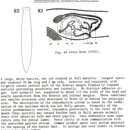Comprehensive Description
provided by Smithsonian Contributions to Zoology
Dendrocoelopsis alaskensis Kenk, 1953:178
HOLOTYPE.–From creek crossing Elliot Highway, Alaska, at milepost 31, set of sagittal serial sections (USNM 22335).
The original description of this species was based on the study of only a few specimens, none of which was at full sexual maturity. Through the courtesy of Dr. Robert L. Rausch of the Arctic Health Research Center at College, Alaska, I received several additional samples of the species, only one of which had the reproductive system developed but not fully differentiated. The following description is taken chiefly from the original publication.
The largest specimen measured was 20 mm long and 4 mm wide (Figure 1C). The anterior end is truncate, with a convex frontal margin and rounded auricular lobes which protrude both anteriorly and laterally, causing a slight narrowing of the lateral margins to appear behind them. There is no adhesive organ visible in live specimens. The body is unpigmented, white. The two principal eyes are about one-third the width of the head apart and the distance of each eye from the frontal margin is equal to, or slightly longer than, the distance from the lateral margin. Supernumerary eyes may appear either anterior or posterior to the principal eyes.
As no fully mature animal could be studied, the description of the reproductive system must be considered to be preliminary, lacking definite morphological and histological details. The testes are predominantly ventral, but individual follicles may be located in the mesenchymal “septa” between the intestinal branches farther toward the dorsal side. The testicular band on either side extends posteriorly to the level of the copulatory complex. The ovaries are situated below the third or fourth pair of intestinal branches. The copulatory organs (Figure 6), though not in their final shape, show the essential characteristics of the genus Dendrocoelopsis. The penis has a round, muscular bulb containing a cavity, the seminal vesicle (vs). The penis papilla in the original specimen is plump and short; in the second specimen, sent by Dr. Rausch, it is slightly more developed and is conical and pointed. The latter also shows the penial lumen better differentiated, into a bulbar seminal vesicle and a narrower ejaculatory duct which opens at the tip of the penis papilla. The two sperm ducts or vasa deferentia (vd) empty into the seminal vesicle separately. The genital atrium (a) is a single cavity, not divided into separate compartments. Its wall, as well as the outer wall of the penis papilla, has the usual circular and longitudinal muscle layers developed below the epithelium. The two oviducts unite above the atrium to form a common oviduct (odc) which opens into the posterior part of the atrium from the dorsal side. The copulatory bursa (b), situated dorsally anterior to the penis bulb, is rather small in both specimens and contains only a small cavity lined with a columnar epithelium. At full maturity the bursa will presumably be much larger and extend farther ventrally. Its bursal duct (bd) consists of a narrower anterior portion running in the dorsal midline above the penis and atrium, and a wider terminal portion, which bends ventrally and connects with the posterior part of the genital atrium. The musculature of the duct consists of intermingled circular and longitudinal fibers.
Dendrocoelopsis alaskensis, a stenothermic and rheophilic species, has been collected so far only in cold, fast streams in the White Mountains, a mountain range north of Fairbanks, Alaska. It generally occurs in the company of another white planarian, Phagocata nivea Kenk.
ALASKA. (1) and (2) Two streams on Steese Highway, at miles 82.5 and 84.0 (Kenk, 1953:180). (3) Stream crossing Elliot Highway at milepost 31.0, type-locality of the species (Kenk, 1953:180). (4) Stream on Elliot Highway at mile 25, several specimens collected by Dr. Robert L. Rausch, 27 August and 12 September 1971.
TAXONOMIC POSITION.–The majority of the species placed in the genus Dendrocoelopsis (in its wider sense, including Amyadenium) are devoid of body pigment, as is D. alaskensis. The five unpigmented species reported from France, i.e., D. brementi (de Beauchamp, 1919), D. vandeli (de Beauchamp, 1931), D. chattoni (de Beauchamp, 1919), D. garmieri (de Beauchamp, 1950), and D. beauchampi (Gourbault, 1969), as well as the species living in Lake Tahoe, D. hymanae Kawakatsu (1968), are blind and are equipped with adhesive organs. Four white species with eyes, i.e, D. spinosipenis (Kenk, 1925), D. americana (Hyman, 1939a), D. lactea Ichikawa and Okugawa (1958), and D. oculata (Porfir’eva, 1958) (originally described as a subspecies of D. brementi), differ from D. alaskensis in the anatomy of their reproductive systems, and some differ in the number and arrangement of the eyes and the development of grasping or adhesive organs. The nearest relative of D. alaskensis appears to be D. hymanae from Lake Tahoe in California and Nevada.
- bibliographic citation
- Kenk, Roman. 1973. "Freshwater triclads (Turbellaria) of North America, VI: the genus Dendrocoelopsis." Smithsonian Contributions to Zoology. 1-16. https://doi.org/10.5479/si.00810282.138

